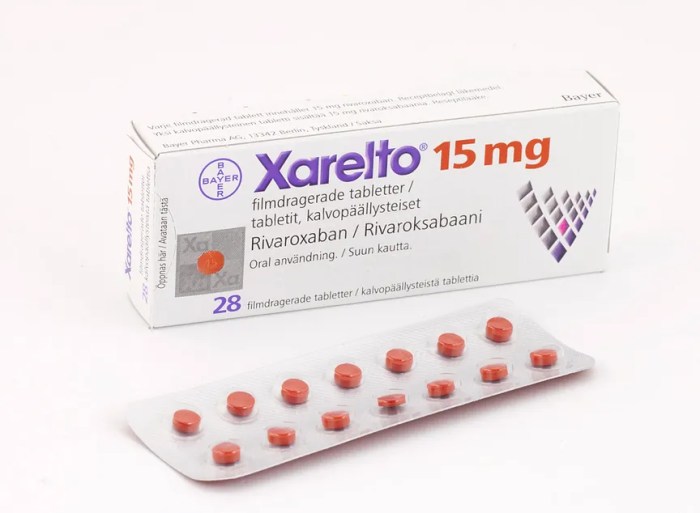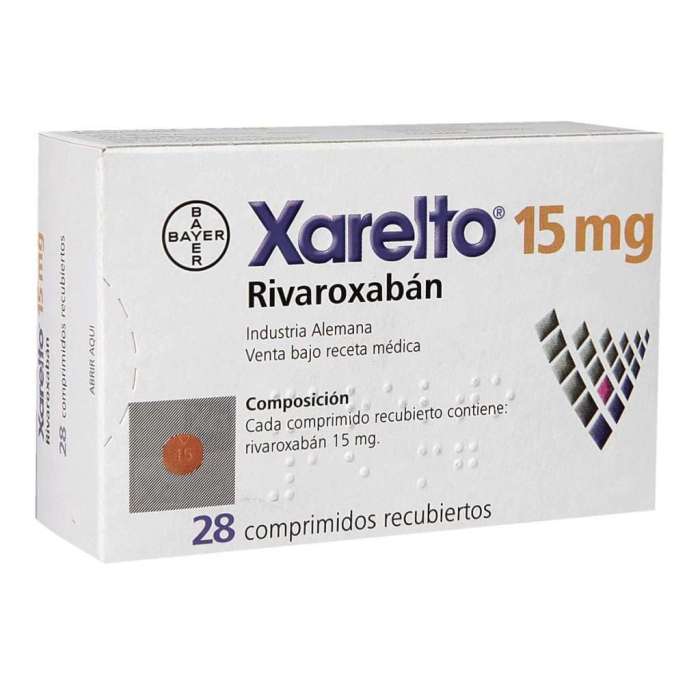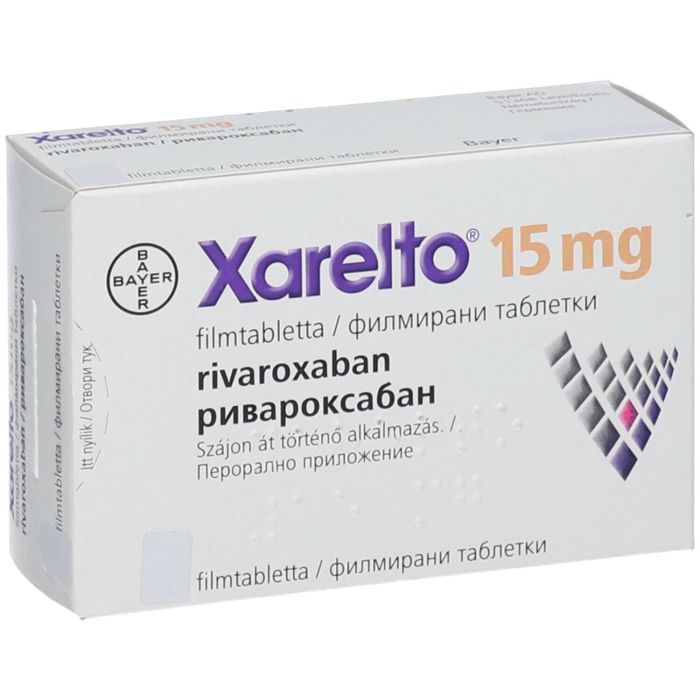Xarelto 15 mg, also known as Rivaroxaban, is a powerful blood thinner prescribed to prevent blood clots in individuals with atrial fibrillation, deep vein thrombosis (DVT), and pulmonary embolism (PE). This medication works by inhibiting clotting factor Xa, effectively reducing the formation of blood clots.
Understanding the dosage, potential side effects, and interactions of Xarelto 15 mg is crucial for safe and effective treatment. This information empowers patients to actively participate in their healthcare journey, ensuring they receive the optimal benefits of this medication while minimizing potential risks.
Xarelto 15 mg

Xarelto 15 mg, also known by its generic name Rivaroxaban, is a blood thinner medication that prevents blood clots from forming. It is a prescription drug that is typically taken once or twice a day, depending on the individual’s condition and medical needs.
Medical Uses
Xarelto 15 mg is primarily prescribed to prevent blood clots in patients with specific medical conditions. These conditions include:
- Atrial fibrillation: This is a heart rhythm disorder that increases the risk of stroke by forming blood clots in the heart. Xarelto 15 mg helps to prevent these clots, reducing the risk of stroke.
- Deep vein thrombosis (DVT): This condition occurs when a blood clot forms in a deep vein, usually in the legs. Xarelto 15 mg is used to prevent DVT in patients who have undergone surgery or have other risk factors.
- Pulmonary embolism (PE): This is a serious condition that occurs when a blood clot travels from the legs to the lungs. Xarelto 15 mg can help to prevent PE in patients who have DVT or are at risk of developing it.
Mechanism of Action
Xarelto 15 mg works by inhibiting the clotting factor Xa, which is a key enzyme involved in the blood clotting process. By blocking factor Xa, Xarelto 15 mg reduces the formation of blood clots, preventing them from forming in the first place.
Dosage and Administration
Xarelto 15 mg is a prescription medication used to prevent blood clots in patients with atrial fibrillation, deep vein thrombosis (DVT), and pulmonary embolism (PE). The dosage and frequency of Xarelto 15 mg vary depending on the patient’s condition, age, and other medications they may be taking.
Dosage and Frequency
The typical dosage of Xarelto 15 mg is one tablet taken orally once a day. However, the dosage may be adjusted based on the patient’s individual needs.
For example, patients with atrial fibrillation may be prescribed a lower dosage of Xarelto 15 mg, such as 10 mg once a day. Patients with DVT or PE may be prescribed a higher dosage, such as 20 mg once a day for the first three weeks, followed by 10 mg once a day for long-term treatment.
Forms of Xarelto 15 mg
Xarelto 15 mg is available in tablet form. The tablets are typically white or off-white, round, and film-coated. They are available in different strengths, including 10 mg, 15 mg, and 20 mg.
Administration
Xarelto 15 mg is typically taken orally with or without food. The tablets should be swallowed whole and not chewed or crushed. It is important to take Xarelto 15 mg at the same time each day to maintain consistent blood levels of the medication.
Dosage Adjustments
The dosage of Xarelto 15 mg may need to be adjusted based on the patient’s medical condition or other factors. For example, patients with severe kidney disease or liver disease may require a lower dosage.
Patients taking other medications that can affect blood clotting, such as aspirin or warfarin, may also need a dosage adjustment.
It is important to talk to your doctor about the appropriate dosage of Xarelto 15 mg for your individual needs.
Potential Side Effects

Like all medications, Xarelto 15 mg can cause side effects. While most people experience minimal or no side effects, it’s crucial to be aware of the potential risks. This section will Artikel the most common and serious side effects associated with Xarelto 15 mg, providing information to help you understand what to look for and when to seek medical attention.
Common Side Effects
Common side effects of Xarelto 15 mg are generally mild and often resolve on their own. These include:
- Bleeding: Xarelto 15 mg works by thinning the blood, making it easier to bleed. This can manifest as nosebleeds, easy bruising, or bleeding from cuts that take longer to stop.
- Gastrointestinal Issues: Some individuals may experience gastrointestinal discomfort, such as stomach upset, nausea, diarrhea, or constipation.
- Skin Reactions: Rash, itching, or hives are possible side effects, though they are less common.
Serious Side Effects
While less frequent, some serious side effects can occur with Xarelto 15 mg. It’s essential to be aware of these and seek immediate medical attention if you experience any of the following:
- Major Bleeding: This could involve bleeding from the stomach, intestines, brain, or other organs. Symptoms may include vomiting blood, black stools, severe headache, confusion, dizziness, or weakness.
- Stroke: In rare cases, Xarelto 15 mg can increase the risk of stroke, especially in individuals with pre-existing conditions like atrial fibrillation. Stroke symptoms can include sudden weakness, numbness, or tingling in the face, arm, or leg, especially on one side of the body, sudden confusion, trouble speaking or understanding, vision problems, dizziness, or loss of balance.
- Allergic Reactions: Although uncommon, allergic reactions to Xarelto 15 mg can occur. Symptoms may include rash, itching, swelling, difficulty breathing, or wheezing.
Recognizing and Responding to Adverse Effects
It’s crucial to be vigilant about any changes in your health while taking Xarelto 15 mg. If you experience any unusual bleeding, bruising, or other concerning symptoms, it’s vital to contact your doctor immediately. Early intervention can help prevent serious complications.
Interactions and Precautions
It is important to be aware of potential drug interactions and precautions when taking Xarelto 15 mg. This medication can interact with other medications, and certain precautions should be taken to minimize the risk of side effects.
Drug Interactions
Drug interactions can occur when Xarelto 15 mg is taken with other medications, potentially increasing the risk of bleeding.
- Medications that increase the risk of bleeding: Xarelto 15 mg should not be taken with other medications that increase the risk of bleeding, such as:
- Nonsteroidal anti-inflammatory drugs (NSAIDs), such as ibuprofen and naproxen
- Aspirin and other salicylates
- Heparin and other anticoagulants
- Some antibiotics, such as doxycycline and minocycline
- Some antifungals, such as fluconazole and ketoconazole
- Herbal supplements: Some herbal supplements, such as ginkgo biloba and garlic, can also increase the risk of bleeding. It is important to inform your healthcare provider about all herbal supplements you are taking.
- Other medications: Xarelto 15 mg may also interact with other medications, such as:
- Certain antidepressants, such as fluoxetine and sertraline
- Certain anticonvulsants, such as phenytoin and carbamazepine
- Certain antivirals, such as ritonavir and saquinavir
Precautions
It is important to take certain precautions when taking Xarelto 15 mg to minimize the risk of side effects.
- Avoid excessive alcohol consumption: Alcohol can increase the risk of bleeding. It is important to avoid excessive alcohol consumption while taking Xarelto 15 mg.
- Inform healthcare providers of all medical conditions: It is important to inform your healthcare provider of all medical conditions, including any allergies, bleeding disorders, or recent surgeries.
- Monitor for bleeding: It is important to monitor for signs of bleeding, such as:
- Unusual bruising or bleeding
- Blood in the urine or stool
- Nosebleeds
- Bleeding gums
- Headaches
- Dizziness
- Weakness
If you experience any of these symptoms, contact your healthcare provider immediately.
- Follow instructions carefully: It is important to follow your healthcare provider’s instructions carefully regarding the dosage and administration of Xarelto 15 mg. Do not stop taking Xarelto 15 mg without consulting your healthcare provider.
Contraindications
Xarelto 15 mg is not suitable for everyone and should not be used in certain situations. Understanding these contraindications is crucial for ensuring patient safety and avoiding potential complications.
Active Bleeding
Active bleeding is a significant contraindication for Xarelto 15 mg. This includes any ongoing bleeding, such as from a recent injury, surgery, or internal bleeding. Using Xarelto 15 mg in such situations could increase the risk of excessive bleeding, potentially leading to life-threatening complications.
Severe Liver Disease
Patients with severe liver disease should avoid Xarelto 15 mg. The liver plays a vital role in metabolizing Xarelto 15 mg. When the liver is severely impaired, it may not be able to process the medication effectively, leading to a buildup of Xarelto 15 mg in the body. This can increase the risk of bleeding.
Certain Types of Artificial Heart Valves
Xarelto 15 mg is not recommended for individuals with certain types of artificial heart valves. These valves are prone to blood clots, and Xarelto 15 mg is not as effective at preventing clots in these situations. In such cases, alternative medications are typically used.
Patient Education

It is important to understand how Xarelto works, its potential side effects, and how to take it safely. This information will help you make informed decisions about your health and treatment.
Key Information About Xarelto 15 mg
Here is a table outlining important information about Xarelto 15 mg:
| Information | Details |
|---|---|
| Dosage | The dosage of Xarelto 15 mg will be determined by your doctor based on your medical condition. |
| Potential Side Effects | Common side effects include bleeding, bruising, and dizziness. More serious side effects may occur, such as stroke or heart attack. |
| Precautions | It is important to inform your doctor about any other medications you are taking, including over-the-counter medications, herbal supplements, and vitamins. You should also inform your doctor if you have any allergies or medical conditions. |
Resources for Additional Information and Support
There are various resources available to help you understand Xarelto 15 mg better and provide support:
- Your Doctor: Your doctor is the best source of information about your specific condition and treatment plan. They can answer any questions you may have about Xarelto 15 mg.
- Pharmacist: Your pharmacist can provide information about the medication, its side effects, and how to take it safely.
- Manufacturer’s Website: The manufacturer’s website often has detailed information about the medication, including patient information leaflets and frequently asked questions.
- Patient Support Groups: Connecting with others who are taking Xarelto 15 mg can provide valuable support and insights.
Sample Patient Education Brochure
This brochure provides essential information about Xarelto 15 mg. It is important to discuss any questions or concerns with your healthcare provider.
What is Xarelto 15 mg?
Xarelto 15 mg is a blood thinner medication that helps prevent blood clots from forming. It is used to treat and prevent blood clots in the legs and lungs, and to reduce the risk of stroke in people with atrial fibrillation (an irregular heartbeat).
How does Xarelto 15 mg work?
Xarelto 15 mg works by blocking the action of a protein in the blood called factor Xa. This protein is involved in the formation of blood clots. By blocking factor Xa, Xarelto 15 mg prevents blood clots from forming.
How should I take Xarelto 15 mg?
Take Xarelto 15 mg exactly as your doctor prescribes. Do not change the dosage or stop taking the medication without talking to your doctor.
What are the possible side effects of Xarelto 15 mg?
The most common side effect of Xarelto 15 mg is bleeding. Other possible side effects include bruising, dizziness, and stomach upset. If you experience any serious side effects, such as severe bleeding, contact your doctor immediately.
What precautions should I take while taking Xarelto 15 mg?
It is important to inform your doctor about any other medications you are taking, including over-the-counter medications, herbal supplements, and vitamins. You should also inform your doctor if you have any allergies or medical conditions. Avoid activities that may increase your risk of bleeding, such as contact sports or using sharp objects.
What should I do if I miss a dose of Xarelto 15 mg?
If you miss a dose of Xarelto 15 mg, take it as soon as you remember. If it is almost time for your next dose, skip the missed dose and take your next dose at the regular time. Do not take a double dose to make up for a missed dose.
Can I take Xarelto 15 mg with alcohol?
It is best to avoid alcohol while taking Xarelto 15 mg. Alcohol can increase the risk of bleeding.
How long should I take Xarelto 15 mg?
The length of treatment with Xarelto 15 mg will vary depending on your medical condition. Your doctor will determine the appropriate duration of treatment.
Can I stop taking Xarelto 15 mg on my own?
Do not stop taking Xarelto 15 mg without talking to your doctor. Stopping the medication abruptly can increase your risk of blood clots.
Can I drive or operate machinery while taking Xarelto 15 mg?
Xarelto 15 mg may cause dizziness. If you experience dizziness, avoid driving or operating machinery until you feel better.
What should I do if I have any questions or concerns about Xarelto 15 mg?
If you have any questions or concerns about Xarelto 15 mg, contact your doctor or pharmacist. They can provide you with the best advice for your specific situation.
Xarelto 15 mg plays a significant role in managing blood clotting disorders, offering patients a vital tool for preventing potentially life-threatening complications. While the medication offers numerous benefits, it’s essential to be aware of potential side effects, interactions, and contraindications. Consulting with a healthcare professional ensures safe and effective treatment, empowering patients to make informed decisions about their health.
Xarelto 15 mg is a common blood thinner prescribed for conditions like deep vein thrombosis (DVT) and pulmonary embolism (PE). It’s crucial to understand the potential risks and benefits associated with any medication, especially when it comes to blood thinners. For instance, the tph law may provide information about the legal ramifications of using Xarelto 15 mg in specific situations, such as driving or operating machinery.
Consulting your healthcare provider is essential for determining the appropriate dosage and potential interactions with other medications.